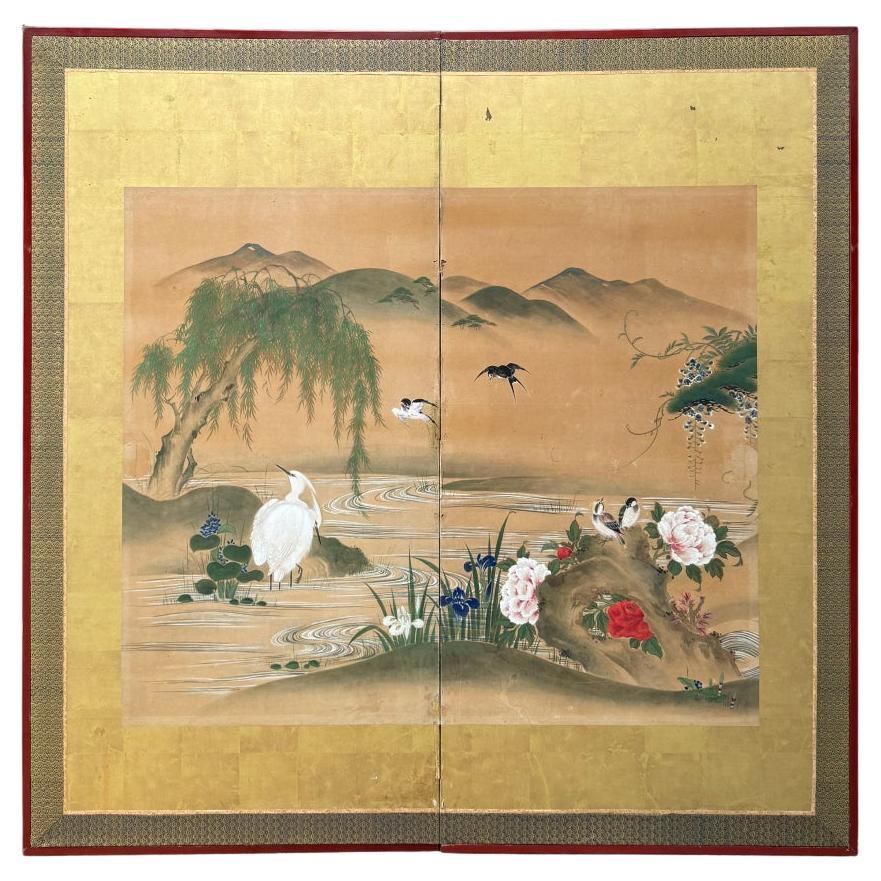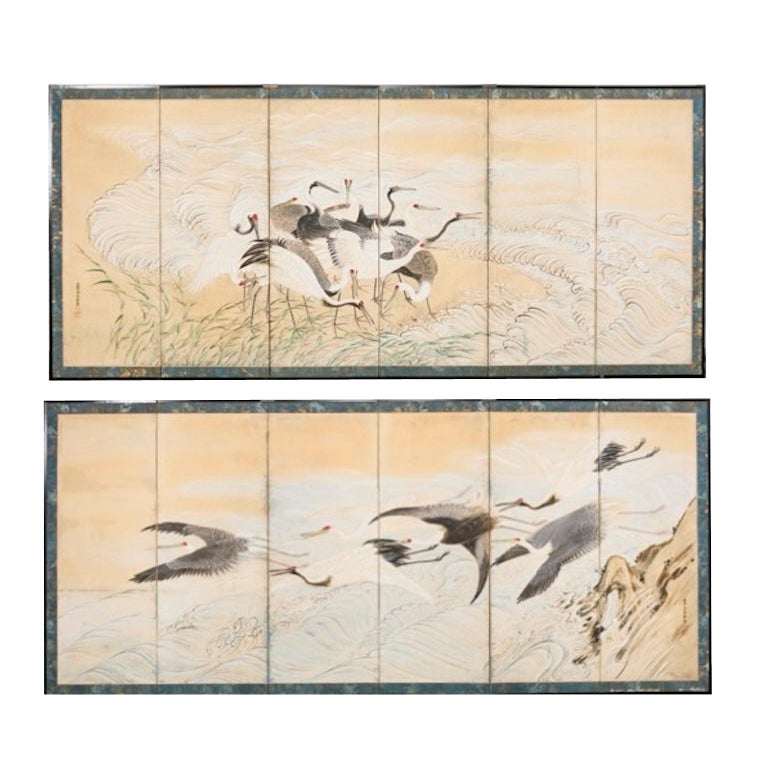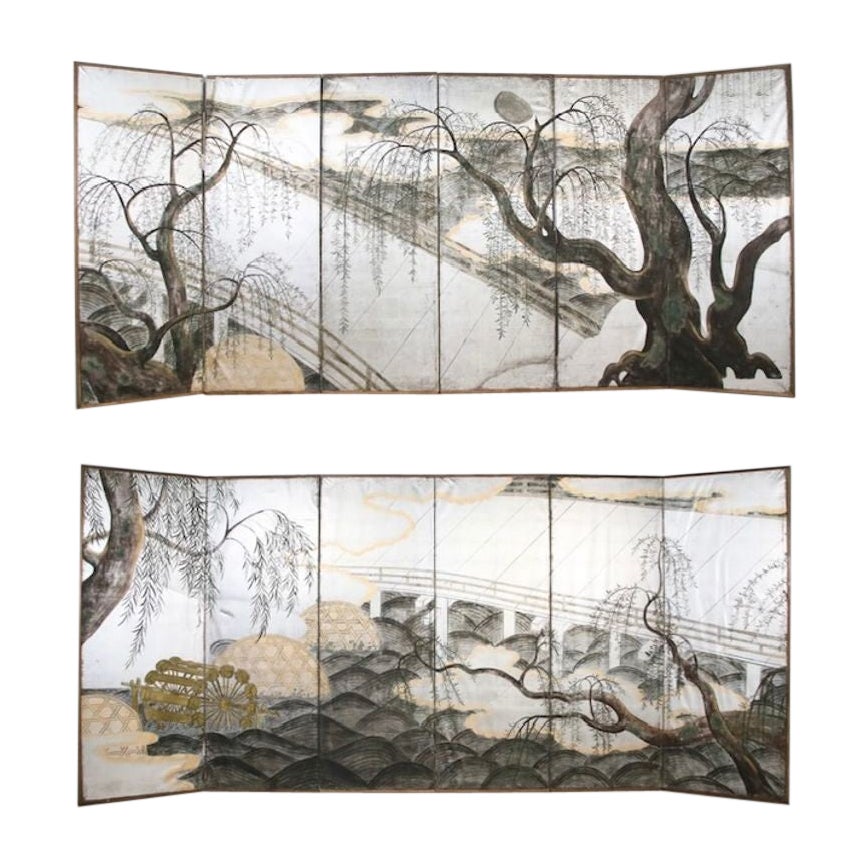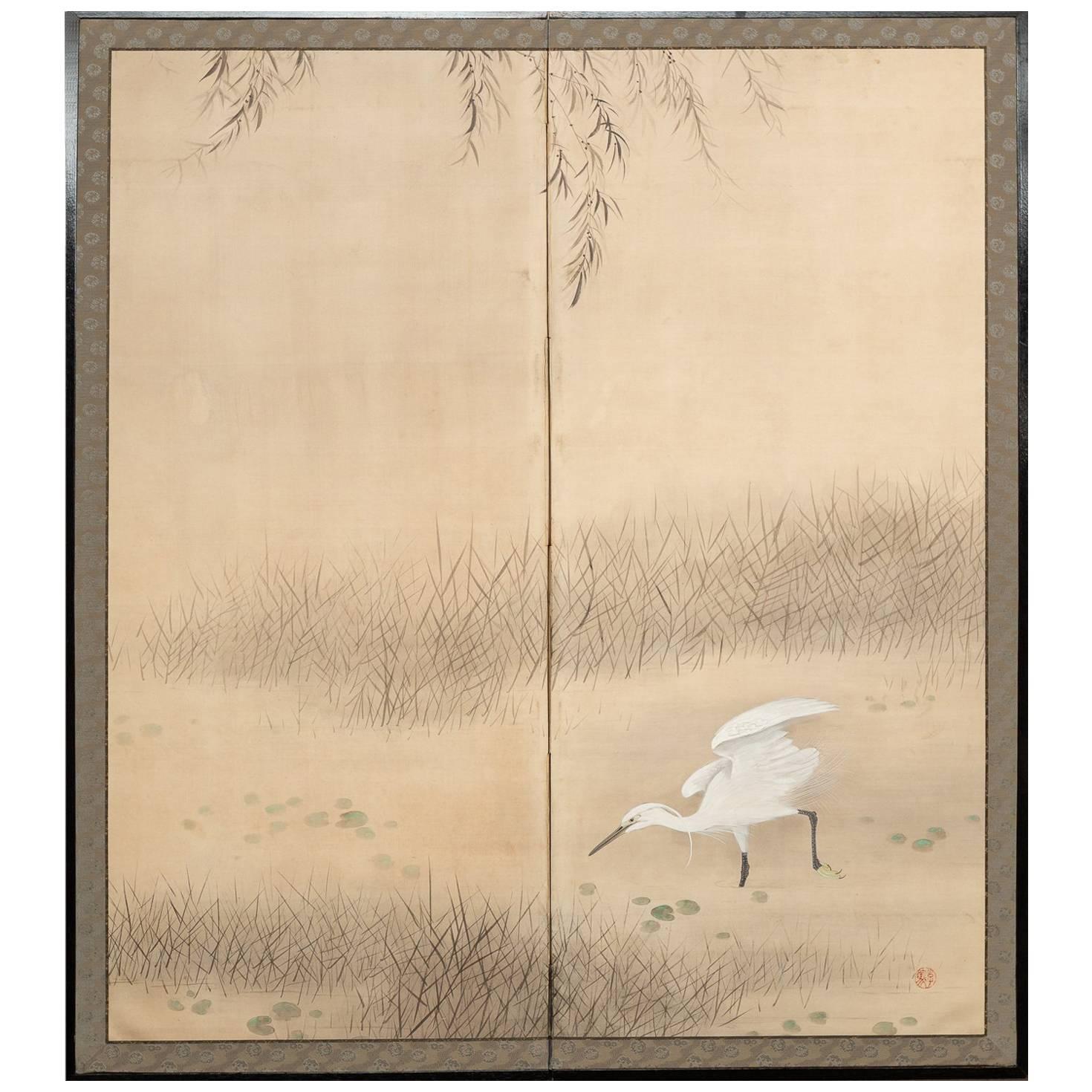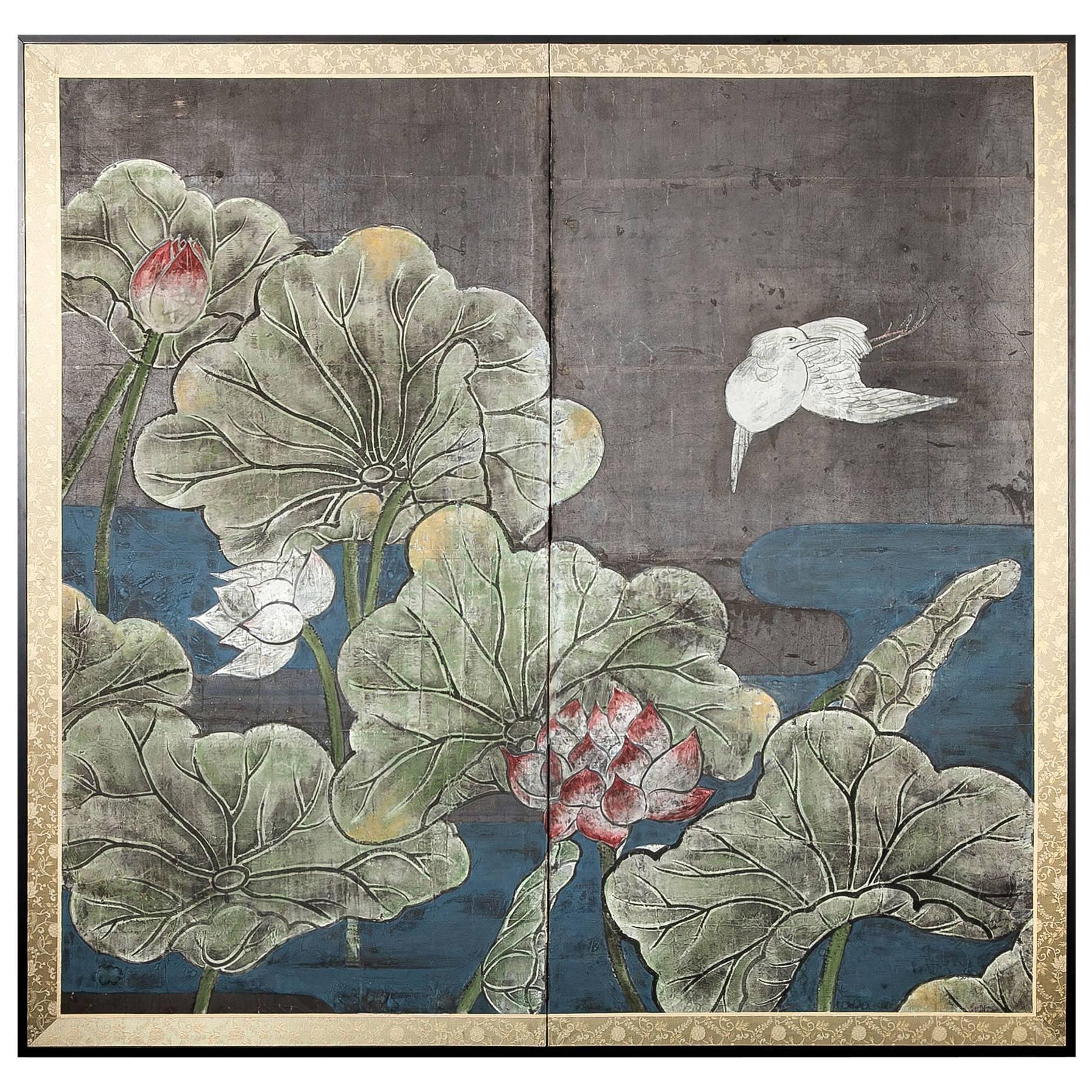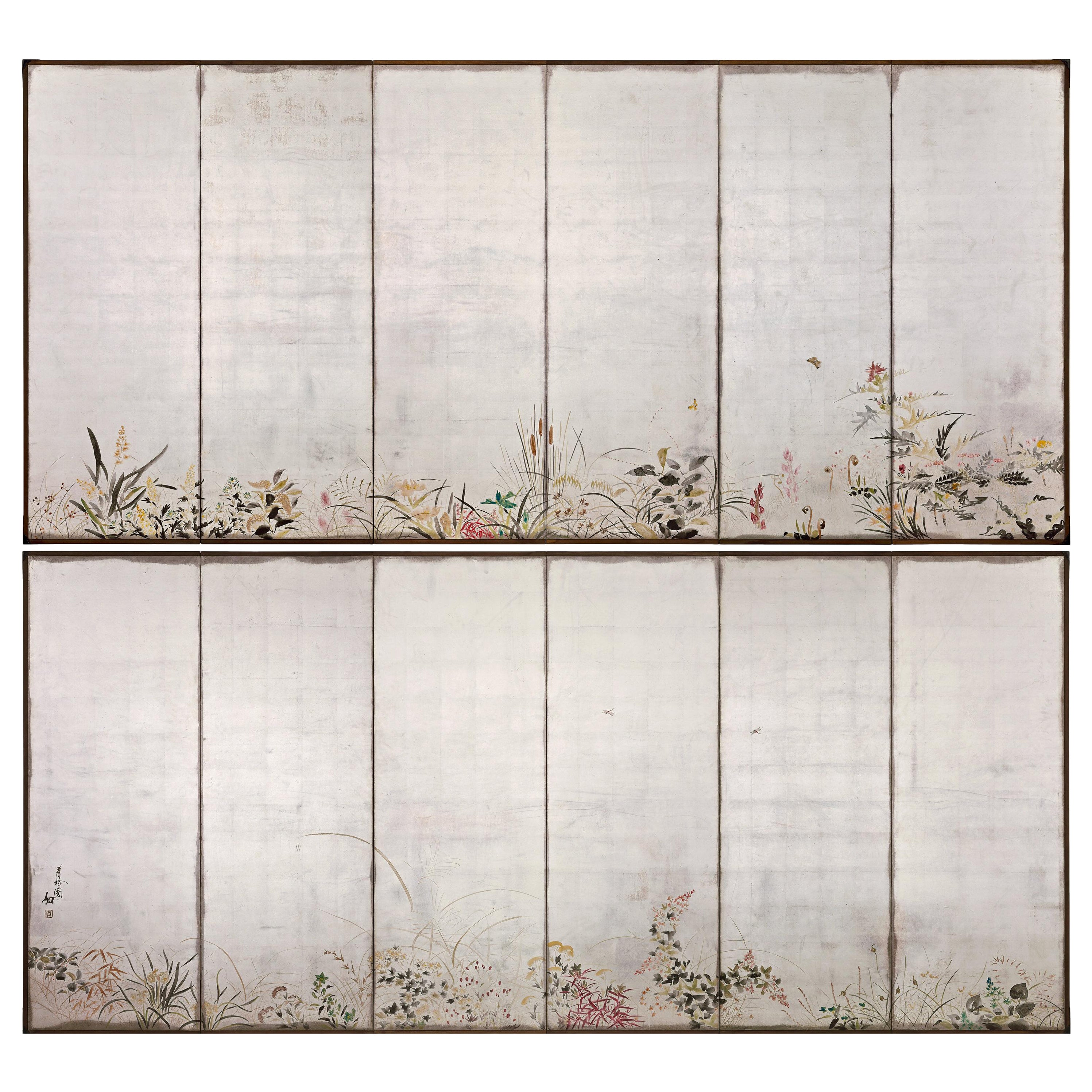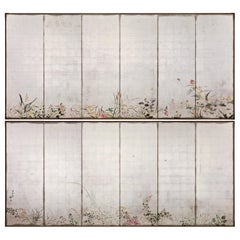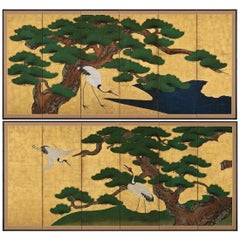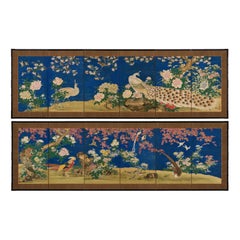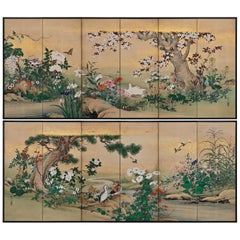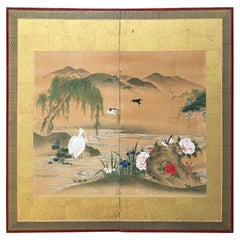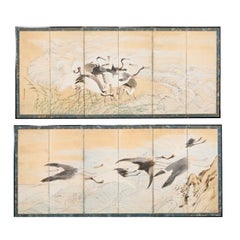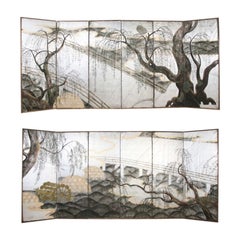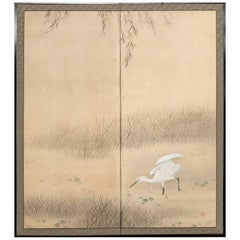Items Similar to Japanese Silver Screen Pair, Meiji Period, Herons & Plovers, Shijo School
Want more images or videos?
Request additional images or videos from the seller
1 of 11
Japanese Silver Screen Pair, Meiji Period, Herons & Plovers, Shijo School
$22,500per set
£17,072.48per set
€19,520.86per set
CA$31,426.40per set
A$34,941.88per set
CHF 18,244.72per set
MX$425,327.76per set
NOK 232,794.70per set
SEK 218,117.51per set
DKK 145,687.75per set
Shipping
Retrieving quote...The 1stDibs Promise:
Authenticity Guarantee,
Money-Back Guarantee,
24-Hour Cancellation
About the Item
Heron & Plovers
Ink and silver leaf on paper
Maekawa Bunrei (1837-1917)
A pair of low six-panel Japanese screens by Maekawa Bunrei, a later master of the Kyoto based Shijo school of painting. On the right screen a solitary white heron stands motionless in a stream. On the left screen plovers play along a shoreline. The elegant forms are executed employing fluid, minimalistic ink brushstrokes. The soft brushstrokes and the sharp light of the silver leaf lend the scenes a sense of translucence. The sophisticated composition superbly exploits the long, horizontal pictorial surface of the pair of folding screens. The origins of Shijo school painting are closely linked with Haiku poetry. Like Haiku, Shijo attempts to capture an immediate, subjective reaction to a stimulus from the world of nature. Naturalism is eschewed for the psychological impression taken from it. As in Haiku, simplification, the reduction of a scene to its most basic signifying elements, is at the core of Shijo work.
With their simplified design, masterful use of negative space and clarity of expression, this pair of screens represents the height of the Shijo school.
Maekawa Bunrei (1837-1917) was a Kyoto based Shijo school artist. He studied painting under his father Maekawa Gorei (1806-1876), who in turn was a pupil of Matsumura Keibun (1779-1843). He was particularly known for his paintings of birds and flowers. He played an active role of the Kyoto painting scene of the Meiji era. He was a member of the Kyoto Art Association (Jounsha). He worked at the Kyoto Prefectural Painting School at its inception and was a judge at the Kyoto Japan Youth Painting Association. He was also a frequent exhibitor at Japan’s National Industrial Exhibitions.
- Dimensions:Height: 35 in (88.9 cm)Width: 98 in (248.92 cm)Depth: 0.75 in (1.91 cm)
- Sold As:Set of 2
- Style:Meiji (Of the Period)
- Materials and Techniques:
- Place of Origin:
- Period:1900-1909
- Date of Manufacture:circa 1900
- Condition:Wear consistent with age and use.
- Seller Location:Kyoto, JP
- Reference Number:1stDibs: LU2472328307472
About the Seller
5.0
Recognized Seller
These prestigious sellers are industry leaders and represent the highest echelon for item quality and design.
Established in 2001
1stDibs seller since 2016
70 sales on 1stDibs
Typical response time: 6 hours
- ShippingRetrieving quote...Shipping from: Kyoto, Japan
- Return Policy
Authenticity Guarantee
In the unlikely event there’s an issue with an item’s authenticity, contact us within 1 year for a full refund. DetailsMoney-Back Guarantee
If your item is not as described, is damaged in transit, or does not arrive, contact us within 7 days for a full refund. Details24-Hour Cancellation
You have a 24-hour grace period in which to reconsider your purchase, with no questions asked.Vetted Professional Sellers
Our world-class sellers must adhere to strict standards for service and quality, maintaining the integrity of our listings.Price-Match Guarantee
If you find that a seller listed the same item for a lower price elsewhere, we’ll match it.Trusted Global Delivery
Our best-in-class carrier network provides specialized shipping options worldwide, including custom delivery.More From This Seller
View Allcirca 1930 Japanese Silver Screens by Isoi Joshin, Flowers of the Four Seasons
Located in Kyoto, JP
Flowers of the four seasons
Isoi Joshin (1883-1964)
Pair of six-panel Japanese screens
Ink, pigment, lacquer and silver leaf on pa...
Category
Mid-20th Century Asian Showa Paintings and Screens
Materials
Silver Leaf
Circa 1700 Japanese Screen Pair, Cranes & Pines, Kyoto Kano School
Located in Kyoto, JP
Pines and Cranes
Anonymous. Kyoto Kano School.
Late 17th/early 18th centuries, circa 1700.
Pair of six-panel Japanese folding screens.
Ink, gofun, pigment and gold leaf on paper.
This bold composition presents two pine trees extending to the left and right across a gold leaf background. One tree is silhouetted against a green ground, golden clouds obscuring its true size, the other stretches across a stylized waterway. The pines are paired with Manchurian cranes with red crests and snow white plumage. Both have been highly auspicious motifs in East Asia since Chinese antiquity. Here the artist utilized fluid and instinctive ink brushstrokes to define the trunk, branches and tail feathers, in strong contrast to the precision and sharp angularity of the crane’s legs and beaks. The adoption of this vast metallic painting support required an unerring sense of design and composition, so that the negative space surrounding motifs could imply context for the otherwise floating pictorial elements. The brushwork detailing the trunks of the pines, the exaggerated dimensions of the pine trees and the strength and dynamism of the composition are all reminiscent of Kano Eitoku...
Category
Antique Late 17th Century Japanese Edo Paintings and Screens
Materials
Gold Leaf
Mid 19th Century Japanese Screen Pair. Flowers & Birds of the Four Seasons.
Located in Kyoto, JP
Shioka Sorin (1781-1850)
Flowers & Birds of the Four Seasons
Pair of six-panel Japanese Screens. Ink, gofun and pigments on silk.
Dimensions (each screen): H. 91.5cm x W. 285cm (3...
Category
Antique Mid-19th Century Japanese Edo Paintings and Screens
Materials
Silk
19th Century Japanese Screen Pair. Flowers & Birds of the Four Seasons
Located in Kyoto, JP
Flowers & Birds of the Four Seasons
Pair of six-fold Japanese Screens. Ink, color, gofun and gold on paper.
Second half of the 19th Centur...
Category
Antique Late 19th Century Japanese Meiji Paintings and Screens
Materials
Wood, Paper
17th Century Japanese Screen Pair by Soga Nichokuan, Hawks on Pine & Plum Trees
Located in Kyoto, JP
Hawks on plum and pine
Soga Nichokuan (active circa 1625-1660)
Pair of six-fold screens.
Ink, mineral pigments, gofun, gold and speckled gold l...
Category
Antique 1640s Japanese Edo Paintings and Screens
Materials
Wood, Paper
17th Century Japanese Screen Pair. Flock of Cranes. Ink and color on gold leaf.
Located in Kyoto, JP
A pair of six-fold Japanese screens from the 17th century depicting a flock of cranes arriving at their wintering grounds. The expansive scene is heavily atmospheric. The cranes are...
Category
Antique 17th Century Japanese Edo Paintings and Screens
Materials
Gold Leaf
You May Also Like
Meiji periof Nature scene with herons
Located in Fukuoka, JP
Meiji periof Nature scene with herons
Peroid: Meiji
Size: 154 x 155 cm (60.6 x 61 inches)
SKU: SD224
The artwork showcases a serene natural landscape that harmoniously blends vario...
Category
Antique 19th Century Japanese Meiji Paintings and Screens
Materials
Wood, Paper
Pair of Japanese Meiji Six Panel Screen Cranes Above Cresting Waves
Located in Rio Vista, CA
Amazing 19th century pair of large Japanese Meiji period six panel screens each depicting a sedge of Manchurian red-crowned cranes along the shore. The screens are crafted in the Nihonga school style with intricate details and beautifully depicted cresting waves. Each screen is signed by artist Hakundo Keikan and studio name of Watahiki Tokai (Japanese 1837-1915). Both screens are signed with red seals on the left and right side. Tokai was a Chinese scholar from the late Edo period and served in the Imperial Household...
Category
Antique 19th Century Japanese Meiji Paintings and Screens
Materials
Brass
Pair of Japanese Silver Leaf Meiji Period Painted Screens
Located in Dallas, TX
The product is a pair of Japanese silver leaf Meiji period painted screens. These screens showcase intricate artwork and designs typical of the Me...
Category
Antique 19th Century Japanese Paintings and Screens
Materials
Wood
Japanese Two Panel Screen, Heron In Water Lily Pond Under Willow
Located in Hudson, NY
Japanese Screen painted with Heron In Water Lily Pond Under Willow. Meiji period (1868 - 1912) painting of a heron at pond's edge. Painted in min...
Category
Early 20th Century Japanese Meiji Paintings and Screens
Materials
Wood, Paper
Japanese Two Panel Screen, Lotus and Heron
Located in Hudson, NY
Japanese two panel screen, lotus and heron
Colored mineral pigments on silver leaf on handmade mulberry paper.
Category
Antique Late 19th Century Japanese Paintings and Screens
Japanese Antiques, Reeds and geese, silver folding screens set, ink, by Shoko
Located in Niiza, JP
The material is silver paper.
Unfolded size: 3760 x 1180 mm
Folded size: 470 x 1180 x 105 mm, 7 kg per piece
Estimated size after packaging (sandwiched between 5 mm plywood): 30 CM x...
Category
Antique 19th Century Japanese Paintings and Screens
Materials
Paper
More Ways To Browse
Long Horizontal
Japanese Antique Silver
Japanese Silver Leaf
Hand Painted Japanese Screen
Japanese Meiji Panel
Pair Of Japanese Paintings
Japanese Folding Screen Screen
Heron Bird
Meiji Period Japanese Screen
Japanese Screen Silver
Japanese Screens Flowers
Japanese Folding Screen Art
Antique Heron
Japanese Screen Kyoto
Pair Of Japanese Screens
Painted Panel Screen Birds
Antique Asian Folding Screen
Kyoto Screens
